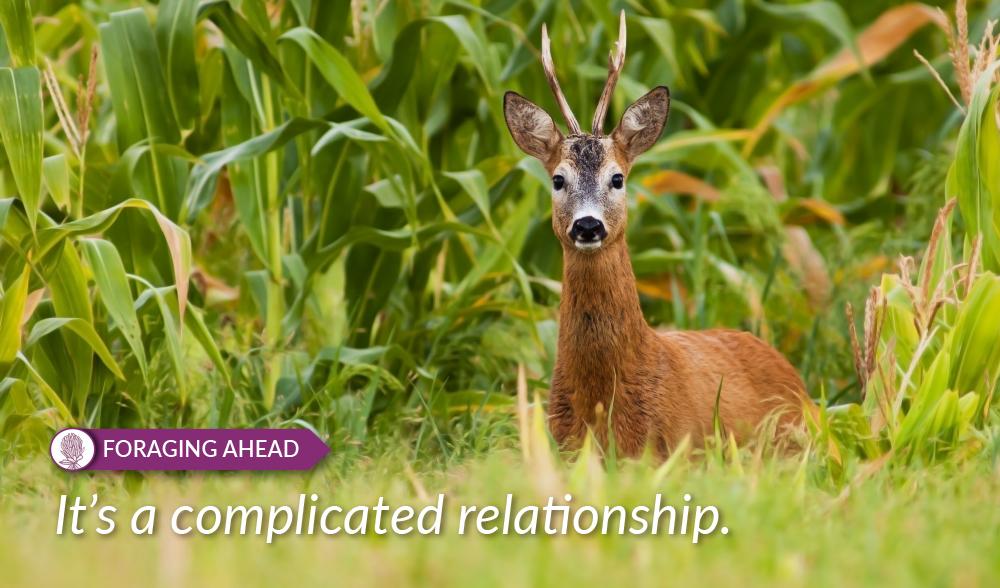
Wild animals have always felt free to visit pastures, hayfields (and various other farm crops) anytime they want. In fact, some wild animals even alter their range in order to access certain crops more easily or more frequently. Farmers, including livestock and hay producers, regularly have the experience of seeing birds and animals of many species on their farms, whether they want to or not!
Face facts: Forage attracts wildlife
Forage crops, even when planted primarily for livestock or hay, make numerous important contributions to wildlife and to the environment. For instance, in areas where cities encroach on agricultural land, there would be little habitat suitable for many types of wild animals if there were no forage crops present.
A high percentage of Americans have a great appreciation for nature and the environment, as evidenced by widespread interest in outdoor activities including hiking, camping, and bird watching. Most people, even urbanites, like the idea of enhancing wildlife populations. The fact that forage crops benefit wildlife in many situations is a point that needs to be made on a regular basis, as it puts agriculture in a good light.
Wildlife isn’t always great for crops
Most producers consider the opportunity to see wild animals as a fringe benefit of living on a farm. However, there is often is a negative side to having high populations of certain species of wildlife on a farm. They sometimes cause damage. In particular, a dense population of deer can result in a significant amount of damage to crops such as corn andsoybeans, and to lush, high-quality growth of forage crops such as alfalfa.
The populations of various species of wildlife on different farms and even different fields on a given farm varies tremendously. Location can be important for several reasons. Proximity to water and cover are two major factors that influence animal behavior. This is why the greatest crop damage generally occurs in areas near the edge of a woodland area, fencerow or water source. Also, in general, wild animals prefer to stay away from areas where there is a good deal of human activity or presence of dogs or other potentially threatening animals.
Wildlife is driven by hunger
Food supply also affects animal behavior. The amount and type of food naturally available is typically quite dynamic, resulting in animals being bolder at certain times than at others. This also affects what they will eat. Deer provide a good example, as they prefer a diverse diet and normally are quite selective. However, in an area in which there is a dense deer population, at certain times of the year there may be virtually no vegetative material to a height of five feet or more. This helps explain why many deer repellants on the market may work well for a while but often ultimately fail. Hunger overrides preferences.
In most of the USA, deer consume more forage than any other wild animal. With row crops or a hay crop such as alfalfa, it isn’t difficult to detect deer damage. However, in pastures one cannot determine how much forage was consumed by deer versus by livestock.

In some parts of the world, other animals consume significant amounts of forage. For example, rabbits were introduced into New Zealand in the latter part of the 20th century. Because there were few predators in that country, rabbit populations exploded, forcing most livestock producers to erect rabbit fencing around their pastures and hay crops.
Even today, the extent to which some forage crops planted for pasture or hay production are used by wildlife is almost certainly underestimated by most producers. After all, wild animals are shy and secretive and generally prefer to avoid being near humans. Many are primarily or exclusively nocturnal, and thus are active only at times when humans are not generally present. Consequently, most forage producers, especially those who grow lush, high-quality forage crops, are doing their part to enhance wildlife populations . . . whether they want to or not.
***
Foraging Ahead is a bi-weekly column presented by Ragan & Massey and written by Dr. Don Ball, Professor Emeritus at Auburn University. Dr. Ball is one of the authors of the popular book, “Southern Forages,” available here.
Follow Ragan & Massey!
Be sure to follow Ragan & Massey on Facebook and Twitter for daily updates, and check back here every week for more in-depth expertise, advice and product updates.
